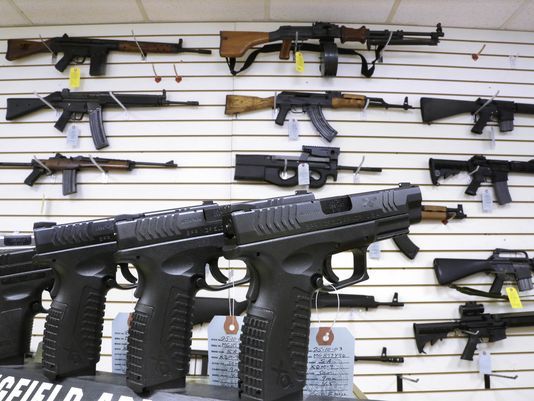
The Dick’s Sporting Goods ban on assault-style weapons, high-capacity magazines and gun sales to buyers under 21 sparked a blitz of mostly positive social media buzz, but it probably won’t slow guns sales.
While gun-control proponents hailed the ban, which comes two weeks after the Parkland, Fla., school shooting, the extremely fragmented nature of the U.S. weapons industry means that most people who want a gun won’t have any trouble finding one.
In fact, any signs that guns are getting harder to buy could actually help boost sales, experts say. About 6,800 shops, 56,000 federally licensed dealers and 8,000 pawnbrokers are allowed to sell guns in the U.S. Gun buyers can also access firearms most weekends at shows at fairgrounds and event spaces across the country, giving Americans plenty of places to buy a weapon.
That said, Wednesday’s announcement by the nation’s largest sporting goods retailer to end sales of assault-style guns could pave the way for other major sellers to get out of the business, allowing the other venues to dominate the space.
U.S. new-rifle sales rose to 4.3 million in 2016 from 3.2 million in 2012, with assault-style weapons likely making up most of the growth, said Aaron Karp, a consultant to the Geneva, Switzerland-based Small Arms Survey and a political science lecturer at Old Dominion University in Virginia.
“The market is big enough to sustain the loss of particular sellers and niches like teenagers,” Karp said in an email. “Any losses will be more than offset by increased sales overall,” he said, adding that the gun market thrives on fear. “The threat of more restrictions is exactly what sellers hope for — something to drive customers into their stores.”
Dick’s Field & Stream-branded chain of about 35 stores focused on outdoor products was one of the only major retailers still selling assault-style rifles. Walmart got out of the business in 2015.
Outdoor goods retailers Cabela’s and Bass Pro Shops, which are now the same company operating nearly 200 locations, are still selling the rifles. It did not respond to requests seeking comment.
Gun-rights proponents moved quickly to support retailers who sell assault-style rifles. The National Shooting Sports Foundation said Wednesday that it was “disappointed” by Dick’s new policy.
“We note that the Dick’s Sporting Goods announcement acknowledges the vast majority of gun owners are responsible and law-abiding,” the foundation said in a statement. “Indeed, they are and should not be penalized for the actions of criminals.”
Though the company does not provide a specific breakdown, Dick’s gun sales are believed to be a small part of its business. Sales of guns and ammunition are “highly fragmented and characterized by a large number of small players,” according to market-research firm IBISWorld.
The four largest gun sellers control only 5% of the market. Compare that with cars, where the four biggest automakers sold about 59% of new vehicles in 2017, according to Autodata.
The U.S. had about 6,804 gun shops in 2017, employing 79,764 workers generating $8.6 billion in revenue, according to IBISWorld.
There are more sellers if you count all the licensed individual dealers. The Bureau of Alcohol, Tobacco and Firearms listed 56,754 federally licensed firearms dealers in 2016, as well as 8,076 pawnbrokers allowed to sell guns.
The ATF said it does not have data on gun sales by individual retailer or category.
But a 2010 survey of consumers by the National Shooting Sports Foundation found that 39% of buyers purchased their most recent “modern sporting rifle” at an independent retail store, 25% online, 10% at a gun show and only 6% at a chain or big-box retailer.
Although online sales have accelerated since then, federal regulations requiring local dealers to fulfill gun purchases have empowered physical shops.
Dick’s had already banned sales of assault-style weapons at its big-box locations after the Newtown, Conn. massacre in 2012. On Wednesday, the retailer extended the ban to include its 35 Field & Stream stores. The ban on sales of guns to anyone under 21 and the ban on sales of high-capacity magazines extends to the entire company.
Dick’s representatives did not respond to requests seeking comment and additional information on the ban.
In an open letter, Dick’s CEO Ed Stack called for a nationwide ban on assault-style weapons, a minimum age of 21 to buy a gun, “universal background checks” and bans on high-capacity magazines and bump stocks.
“We support and respect the Second Amendment, and we recognize and appreciate that the vast majority of gun owners in this country are responsible, law-abiding citizens,” Stack wrote. “But we have to help solve the problem that’s in front of us. Gun violence is an epidemic that’s taking the lives of too many people, including the brightest hope for the future of America — our kids.”
Although gun sales might not be affected much by Dick’s decision, other retailers could consider similar moves after seeing the support for the company.
“Not a big dent, but a helpful start,” was how Joseph Holt, a business ethicist at the University of Notre Dame, described the impact. “The guns that cause the mass carnage are disproportionately the semi-automatic weapons.”
About 79% of consumer sentiment expressed on social media about the Dick’s decision was positive, according to data analysis firm Sprout Social.
The buzz could inspire fans to be more loyal to Dick’s. A recent study by public relations firm Edelman found that 57% of consumers worldwide will buy or boycott a specific company based on its position on political or social issues. And 30% say they’re more likely to buy products and services based on their beliefs than they were three years ago.
“When a brand takes a stand on a particular issue, people will take notice,” said Mark Renshaw, global chair of Edelman’s brand practice. “And they’ll take action and support companies that they believe are aligned with their values.”

